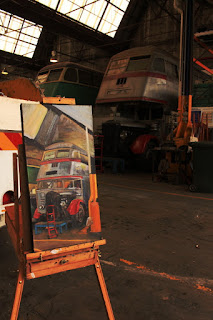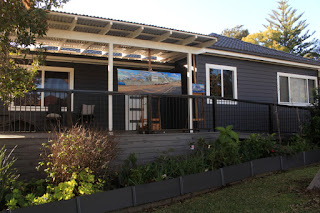Today's painting on the deck gallery is a streetscape of Merriman Street, Millers Point.
These colourful terraces are just next to the Barangaroo Headland Park, and at the time of painting, still lay in the shadow of the now demolished Harbour Control Tower, which actually used to have an entrance on Merriman street directly opposite the terraces in this canvas. The Palisade Hotel is just at the end of the street.
They face west and I caught them in the full light of the setting sun to enhance their faded gelato colours so reminiscent of the dilapidated charm of urban Cuba. I kept expecting to hear the Buenavista Social Club from every doorway.
They also reminded me of streetscapes by Jeffrey Smart and Edward Hopper. Behind the colourful facade is a threatening storm.
 |
MP11 'Merriman st' 2014
oil on canvas 46 x 61cm
Available
|
|
Sharp eyed viewers will be able to see yellow ribbons tied to the doors. A yellow ribbon had been used to mark a building destined for demolition, during the original Rocks clearances in the late 19th - early 20th century. The current residents adopted and repurposed this symbol to signal a building where the occupants were threatened with eviction.
 |
MP11 'Merriman st' 2014
oil on canvas 46 x 61cm
Available |
The early 20th century slum clearances in Millers Point
and the Rocks were performed under the pretext of saving the city from
bubonic plague. The early 21st century clearances were of the community
rather than the architecture, under the guise of economic rationalism.
First the maritime workforce, then the surrounding community
was dispersed.
Until recently, the inner city had been regarded as a crowded, squalid
slum, so the rich flocked to the suburbs. Now this has reversed, and the
poor are pushed to the periphery. The city is spoilt
rotten for resources and transport, while the hinterland has been starved.
 |
MP11 'Merriman st' 2014
oil on canvas 46 x 61cm
Available |
Nearly 200 years of
its colourful maritime past has been swept away with barely a token gesture to its
previous existence.Since this canvas was painted, most of Millers Point has passed into private hands, and many of the workers cottages were transformed into short term rental Air B'n'B. Ironically, due to another outbreak of plague (Covid 19 this time, not bubonic) almost exactly a century later, these short term rentals are now mostly vacant and from March to mid June 2020 the Isolation restrictions turned Millers Point into a ghost town.
Related posts






























